
After the
loss of the Samoan Clipper
in 1938,
Pan American did not set up a regular New Zealand - USA service
until 1940.
There were two survey flights in 1939, the first was from San Francisco to
Auckland between 22 and 30 August while the second was between
18 and 24 November [6].
The regular service was known as FAM 19 and was fortnightly
with the first flight being from 12 to 18 July, 1940.
Due to Italy entering World War II in June 1940, this was the only
through airmail route between New Zealand and the UK.
San Francisco to Auckland

The trans-Pacific flight from San Francisco and Los Angeles to Auckland on 12 - 18 July 1940 carried the first ever official airmail from America to New Zealand. (The first New Zealand to US airmail had of course been in 1938.) The plane was the Boeing 314 flying boat American Clipper under the command of Captain J H Tilton.
The size of the mail from San Francisco to Auckland was 16,275 items.

The above cover is postmarked San Francisco at 11am on July 12 and backstamped Auckland on July 18. It was then carried on to the UK, presumably by sea as it is franked with 50c which was the airmail rate from the US to New Zealand.
Registered Cover
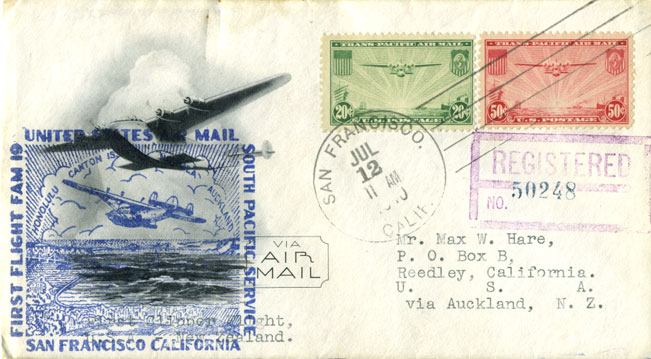
This next cover is addressed to USA and so, after being flown to Auckland was returned to the USA by sea. It is an attractive printed cover whose design is obscured by the San Francisco cachet.
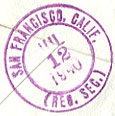
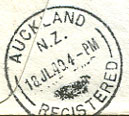
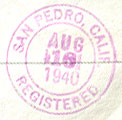
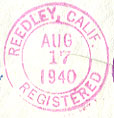
As a registered cover, it is franked with 70c rather than the usual 50c. I assume this was 10c each for the outward and return journeys. It also has a fine array of backstamps allowing its journey to be tracked.
It has the usual San Francisco postmark plus two San Francisco Registered backstamps on 12 July and an Auckland arrival mark on 18 July. It then has a San Pedro backstamp about a month later on 16 August showing that it was returned by sea and landed at the port of San Pedro, California. Finally there is a backstamp at Reedley, California on 17 August.
Acceptances from Europe
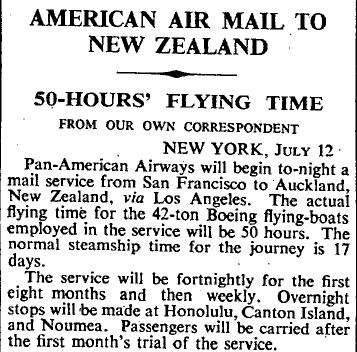
According to Walker [1], air mail which left London on July 6 connected with this flight in San Francisco after being flown trans-Atlantic to New York via Lisbon. However, none of the experts that I have contacted has seen an example of an acceptance from the UK in early July.
The absence of acceptances from UK is surprising as the start of the service from the USA on 12 July was announced in New Zealand on 24 June giving plenty of time. However, the first report that I have found in the British press is the article shown here from The Times of 13 July 1940 and so the reason could be the lack of publicity in the UK.
The UK - New Zealand airmail postage was 4s 6d and this was published in the Post Office Circular of 7 August 1940.
It is interesting to note that none of the covers on this page
had censor marks applied on arrival in New Zealand.
New York - San Francisco - Auckland - Sydney
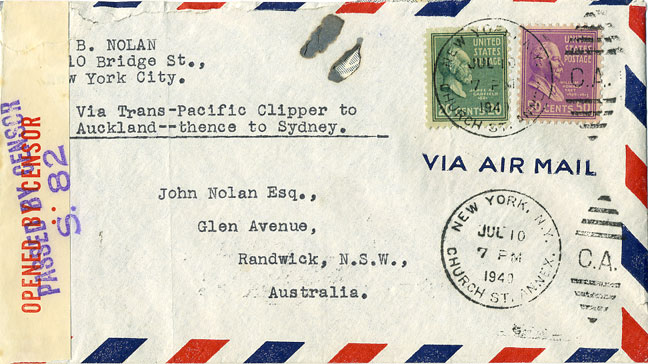

This cover is postmarked in New York on 10 July and was flown to San Francisco to join the first FAM 19 service to Auckland. As it is addressed to Australia, it is franked with 70c, which is 20c more than the rate to New Zealand to pay for the additional trans - Tasman airmail service.
Interestingly, it does not have a San Francisco postmark or the special cachet that was applied in San Francisco although it does have an Auckland backstamp on 18 July to prove that it was flown on the first flight.
According to Walker [1], mail from the UK which connected with the first flight (and
which would have been routed via New York) also did not have
the special cachet added.
The route
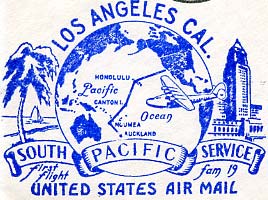
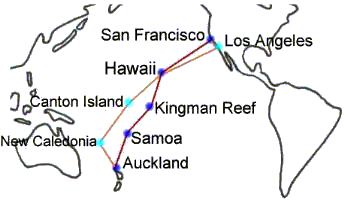
The route to Auckland from San Francisco was via Los Angeles, Honolulu, Canton Island and Noumea in New Caledonia.
Different cachets were applied at each departure point. The Los Angeles cachet showed a map of the route. The mail from Los Angeles to Auckland was 3,751.
New Caledonia and Canton Island had replaced American Samoa and Kingman Reef used in the 1938 flight. Both the 1938 and the 1940 routes are shown on the map.
The Americans really wanted the service to be to Australia, but that was blocked through pressure from the British who also blocked the use of Fiji as a staging post. Fiji was eventually added to the route in November 1941 and, although plans were accepted in November 1941 for a service to Australia, it did not occur as the service was terminated in December 1941 due to the attack on Pearl Harbor. Mail for Australia was flown from Auckland to Sydney by TEAL.
If air mail to Australia missed the fortnightly connection with FAM 19 in San Francisco, it would be sent by the weekly airmail service via Hong Kong [2].
Mail was accepted both from and to intermediate destinations.
From Los Angeles
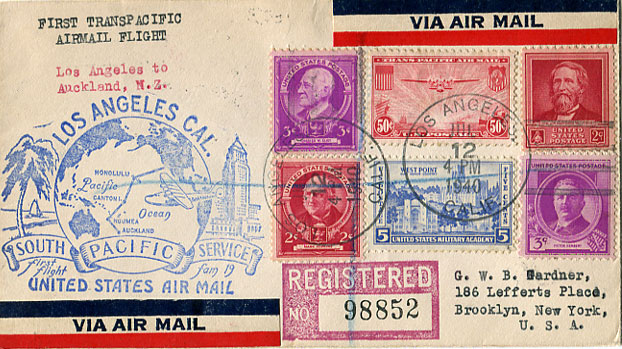
The flight left San Francisco at 12 noon and arrived in Los Angeles at 14.20.
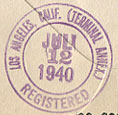
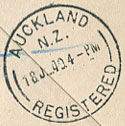
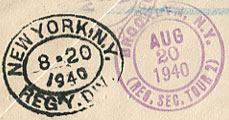
A special cachet was applied and the mail was franked at 4pm which was the intended time of departure. Although the postmark and cachet both refer to Los Angeles, the actual point of departure was San Pedro. The size of the mail from Los Angeles to Auckland was 3,751 items.
This registered cover is franked with an array of stamps making up 65c
in postage compared to 70c in the registered cover shown above although
the postage rate from San Francisco and Los Angeles was the same.
As a registered cover, it has a range of backstamps to track its progress
including its return from New Zealand by sea.
It arrived back in New York on 20 August compared to the 17 August arrival of the
earlier registered cover in Reedley, Caifornia.
From Hawaii
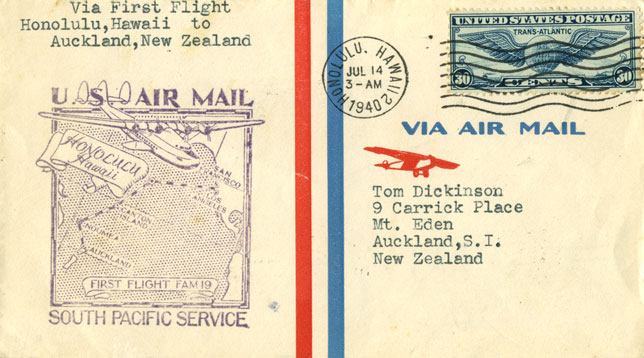
The flight arrived in Honolulu on 13 July and left on the following day and flew to New Zealand via Canton Island and New Caledonia. The Pan American base in Hawaii was Pearl City which was within Pearl Harbor.

More than one slogan backstamp was used on arrival in Auckland on 18 July. This cover has a backstamp supporting the territorials.
The airmail rate from Hawaii to Canton Island was 10c, to New Caledonia 20c and to New Zealand 30c.
The size of the mail from Honolulu to Canton Island was 6,008,
to Noumea 6,734 and to Auckland 7,928.
From Canton Island
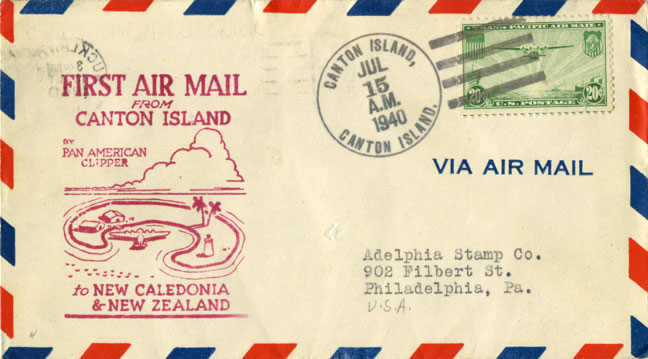
Canton Island was an uninhabited atoll with no fresh water. Pan American Airways built a village together with a desalination plant so that it could act as a staging post.
The flight from USA arrived in Canton Island on 14 July and left again for New Caledonia at 7am on 15 July arriving at 7pm on 16 July. The journey from Canton Island to New Caledonia crossed the International Date Line which is why the leaving date is 15 July and the arrival date in Noumea is 16 July.
The size of the mail from Canton Island to Noumea was 4,626 and from Canton Island to Auckland was 4,720. The special cachet from Canton Island was applied by Pan American staff as the official cachet was delivered on the incoming aircraft and so there would not have been time to cancel the covers.
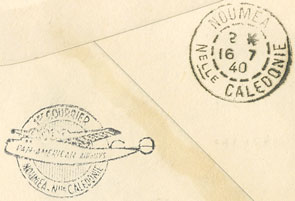
The airmail rate from Canton Island to New Caledonia was 10c and to New Zealand 20c. The mail for New Caledonia was backstamped on arrival as shown. This example is on the back of a cover flown from San Francisco to Noumea. Mail from USA to New Caledonia cost 40c.

The Noumea arrival cachet and backstamp has the same form as the postmark and cachet used on the mail sent from Noumea to New Zealand.
It is interesting to note three different advertising slogans on
the Auckland arrival marks in the above covers.
From New Caledonia
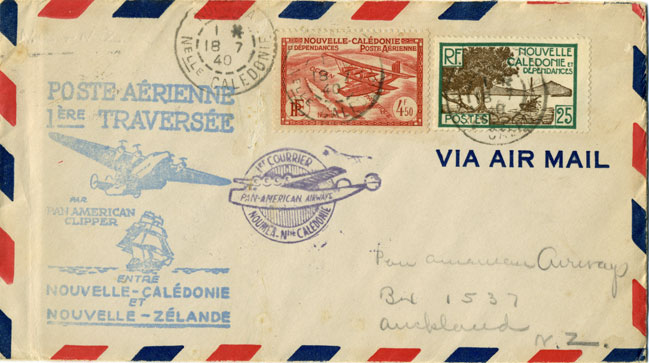
The flight did not leave Noumea until 18 July and arrived in New Zealand the same day. This flight was the first airmail between New Zealand and New Caledonia and the size of the mail from Noumea to Auckland was 6,332.

This cover from Noumea to Auckland is postmarked on 18 July and is backstamped on arrival in Auckland later that day at 3.30pm.
At this time, Pan American had not been granted landing rights
in Australia and it seems clear that their choice of New Caledonia
as a stopping point had more to do with their aim of an Australian - US
service rather than it being the obvious stop on the way to
New Zealand.
All scans were made by the author.
[1] D A Walker, Airmails of New Zealand, volume 2,
Air Mail Society of New Zealand, 1986.
[2] Kimpton L., World War II 'Two Ocean' Mail from the United Kingdom to Australia
and New Zealand, Air Mail News, vol 51, pp 54-62, May 2008.